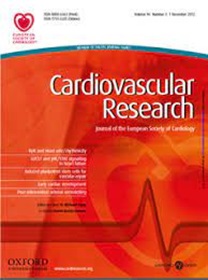靶向CD8+ T细胞治疗心血管疾病——目前的选择和治疗前景
IF 13.3
1区 医学
Q1 CARDIAC & CARDIOVASCULAR SYSTEMS
引用次数: 0
摘要
表达CD8辅助受体的T淋巴细胞,通常被称为细胞毒性T淋巴细胞(CTL),在防御病毒感染和癌症方面至关重要。CD8包含多种蛋白质家族,包括同型二聚体、异源二聚体、同型异构体和剪接变体。CD8αβ异源二聚体是CD8膜蛋白的主要形式,通常锚定在脂筏上,以促进T细胞受体(TCR)的激活。像衣康酸这样的小分子已经被证明可以调节CD8+ T细胞的表达。针对CD8α或CD8β的抗CD8单克隆抗体(mab)可用于在实验模型中研究CD8+细胞的功能。此外,各种免疫成像探针,如89Zr-crefmirlimab berdoxam,已被开发用于预测癌症对免疫治疗的反应。抗CD8单克隆抗体用于治疗与细胞毒性CD8+ T细胞过度活化相关的疾病的潜在用途也在研究中。这包括急性(如缺血性心力衰竭、缺血性中风)、亚急性(如心肌炎)和慢性心血管疾病(动脉粥样硬化)等病症。使用抗cd8单克隆抗体是一种很有前途的治疗策略,可以对抗以T细胞过度细胞溶解活性为特征的疾病。实验模型表明,抗CD8消耗单克隆抗体可以有效地限制CD8+ T细胞引起的组织损伤。因此,在人类身上评估这些治疗方法的时机已经成熟。首个治疗性抗cd8单抗(PLG101)的临床前开发目前正在进行中。本文章由计算机程序翻译,如有差异,请以英文原文为准。
Targeting CD8+ T cells in cardiovascular diseases - current options and therapeutic perspectives
T lymphocytes expressing the CD8 coreceptor, often referred to as cytotoxic T-lymphocytes (CTL), are critical in defending against virus infections and cancers. CD8 encompasses a diverse family of proteins, including homodimers, heterodimers, isoforms, and splice variants. CD8αβ heterodimers are the predominant form of the CD8 membrane protein, often anchored to lipid rafts to facilitate the activation of the T cell receptor (TCR). Small molecules like itaconate have been shown to modulate CD8+ T cell expression. Anti-CD8 monoclonal antibodies (mAbs) targeting either CD8α or CD8β are available to study the functions of CD8+ cells in experimental models. Additionally, various immuno-imaging probes, such as 89Zr-crefmirlimab berdoxam, have been developed to predict the response of cancers to immunotherapy. The potential use of anti-CD8 mAbs to treat diseases associated with hyperactivation of cytotoxic CD8+ T cells is also under investigation. This includes conditions such as acute (e.g., ischemic heart failure, ischemic stroke), subacute (e.g., myocarditis) and chronic cardiovascular diseases (atherosclerosis). The use of anti-CD8 mAbs represents a promising therapeutic strategy to combat diseases characterized by excessive cytolytic activity of T cells. Experimental models have shown that anti-CD8 depleting mAbs can effectively limit tissue damages caused by CD8+ T cells. As a result, the time is ripe to evaluate these treatments in humans. Preclinical development of the first therapeutic anti-CD8 mAb (PLG101) is currently underway.
求助全文
通过发布文献求助,成功后即可免费获取论文全文。
去求助
来源期刊

Cardiovascular Research
医学-心血管系统
CiteScore
21.50
自引率
3.70%
发文量
547
审稿时长
1 months
期刊介绍:
Cardiovascular Research
Journal Overview:
International journal of the European Society of Cardiology
Focuses on basic and translational research in cardiology and cardiovascular biology
Aims to enhance insight into cardiovascular disease mechanisms and innovation prospects
Submission Criteria:
Welcomes papers covering molecular, sub-cellular, cellular, organ, and organism levels
Accepts clinical proof-of-concept and translational studies
Manuscripts expected to provide significant contribution to cardiovascular biology and diseases
 求助内容:
求助内容: 应助结果提醒方式:
应助结果提醒方式:


